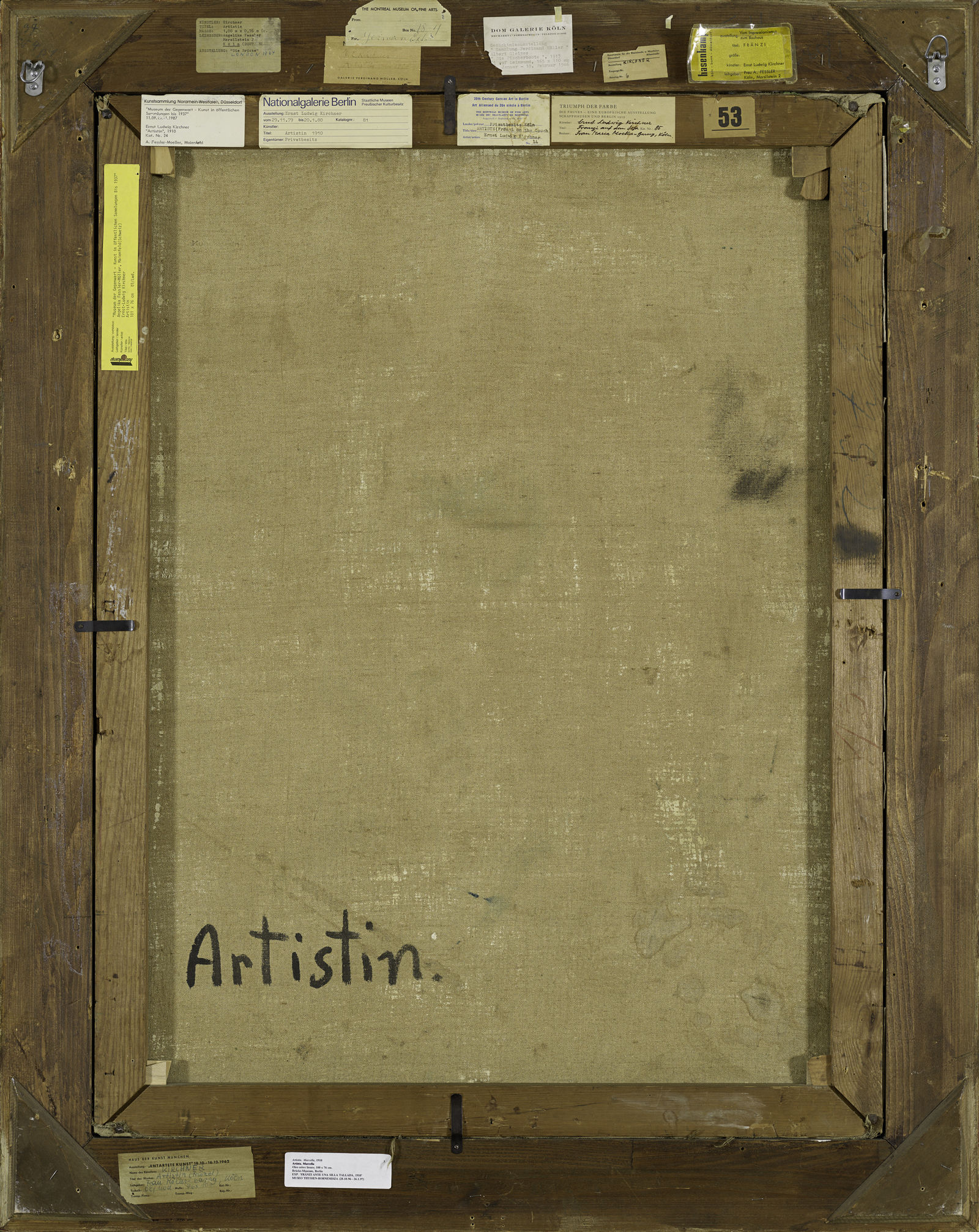

Ernst Ludwig Kirchner
Artistin
Rahmenmaß 120 × 95 × 5 cm
Provenienz
Der Kunstverein Jena erhielt das Gemälde 1917 als Vermächtnis seines Gründers Botho Graef (1857–1917). 1937 wurde es hier im Rahmen der nationalsozialistischen Aktion Entartete Kunst beschlagnahmt. Der Galerist Ferdinand Möller (1882–1956) übernahm das Werk im März 1940, um es im Auftrag des Deutschen Reichs ins Ausland zu veräußern. Stattdessen verblieb es in seinem Besitz. In das Brücke-Museum gelangte die Artistin 1997 durch einen Ankauf aus der Sammlung von Angelika Fessler-Möller (1919–2002), der Tochter des Kunsthändlers.
Exhibitions (selection)
- Der Angriff der Gegenwart auf die übrige Zeit. Künstlerische Zeugnisse von Krieg und Repression, 2023/24, Brücke-Museum, Berlin
Malgorzata Mirga-Tas. Sivdem Amenge. Ich nähte für uns. I sewed for us, 2023, Brücke-Museum, Berlin
How to Brücke-Museum: Ein Blick hinter die Kulissen , 2022/2023, Brücke-Museum, Berlin
1910: Brücke. Kunst und Leben, 2022, Brücke-Museum, Berlin
Flucht in die Bilder? Die Künstler der Brücke im Nationalsozialismus, 2019, Brücke-Museum, Berlin
Die Brücke 1905–1914, 2018/19, Museum Frieder Burda, Baden-Baden
Großstadtrausch – Naturidyll. Kirchner – Die Berliner Jahre, 2017, Kunsthaus Zürich
... die Welt in diesen rauschenden Farben. Meisterwerke aus dem Brücke-Museum Berlin, 2016/17, Landesmuseum für Kunst und Kulturgeschichte Oldenburg
Ernst Ludwig Kirchner. Retrospektive, 2010, Städel Museum, Frankfurt am Main
Literature (selection)
- Magdalena M. Moeller, Das Brücke-Museum Berlin, Prestel, München 1996.
Magdalena M. Moeller (Hg.), Brücke. La nascita dell´espressionismo, Ausst.-Kat. Fondazione Antonio Mazzotta Milan, Mazzotta, Milano 1999.
Magdalena M. Moeller (Hg.), Die Brücke. Meisterwerke aus dem Brücke-Museum Berlin, Ausst.-Kat. Brücke-Museum Berlin, Hirmer Verlag, München 2000.
Magdalena M. Moeller (Hg.), Ernst Ludwig Kirchner. Neuerwerbungen seit 1988, Hirmer Verlag, München 2001.
Javier Arnaldo, Magdalena M. Moeller (Hg.), Brücke. Die Geburt des deutschen Expressionismus, Ausst.-Kat. Berlinische Galerie, Hirmer Verlag, München 2005.
Javier Arnaldo, Magdalena M. Moeller (Hg.), Brücke. El nacimiento del expresionismo alemán, Ausst.-Kat. Museo Thyssen-Bornesza Madrid/Fundación Caja Madrid, Madrid 2005.
Brücke und Berlin. 100 Jahre Expressionismus, Ausst.-Kat. Neue Nationalgalerie, Kulturforum Potsdamer Platz, Nicolai, Berlin 2005.
Magdalena M. Moeller (Hg.), Brücke-Museum Berlin, Malerei und Plastik. Kommentiertes Verzeichnis der Bestände, Hirmer Verlag, München 2006.
Magdalena M. Moeller (Hg.), Brücke Highlights, Hirmer Verlag, München 2007.
Staatssekretär für kulturelle Angelegenheiten des Landes Berlin, André Schmitz (Hg.), Im Zentrum des Expressionismus. Erwerbungen und Ausstellungen des Brücke-Museums Berlin 1988 - 2013. Ein Jubiläumsband für Magdalena M. Moeller, Hirmer Verlag, München 2013.
Magdalena M. Moeller (Hg.), Meisterstücke. Die schönsten Neuerwerbungen des Brücke-Museums, Ausst.-Kat. Brücke-Museum, Hirmer Verlag, München 2013.
Magdalena M. Moeller und Rainer Stamm (Hg.), ... die Welt in diesen rauschenden Farben. Meisterwerke aus dem Brücke-Museum Berlin, Ausst.-Kat. Landesmuseum Oldenburg, Hirmer Verlag, München 2016.
Magdalena M. Moeller (Hg.), Brücke Museum Highlights, Hirmer Verlag, München 2017.
Meike Hoffmann, Lisa Marei Schmidt, Aya Soika für das Brücke-Museum (Hg.), Flucht in die Bilder? Die Künstler der Brücke im Nationalsozialismus, Ausst.-Kat. Brücke-Museum , Hirmer Verlag, München 2019.
Brücke-Museum, Lisa Marei Schmidt, Isabel Fischer (Hg.), 1910. Brücke. Kunst und Leben, ausstellungsbegleitende Zeitung, Brücke-Museum, Berlin 2022.
Details
Tags
Bildgattung: Figurenbild, Bildnis
Schlagwort: Melancholie, Interieur
Album: Tiere
Iconclass
Mädchen, junge Frau
Katze
Behälter aus Glas: Flasche, Gefäß, Vase
den Kopf in einer Hand halten; dabei den Ellenbogen auf eine Erhebung oder auf ein Knie stützen
Schuhe, Sandalen
Couch, Sofa, Polsterbank
Hausinneres
Mensch und Tier
Inscription/Signature
Signiert oben rechts:
EL Kirchner (Signatur)
Rückseitig auf dem Bildträger:
Artistin (Bezeichnung)
Rückseitig auf dem Bildträger:
Artistin (Beschriftung)
Inventory Number
1/97
Catalog Number
Gordon 125

